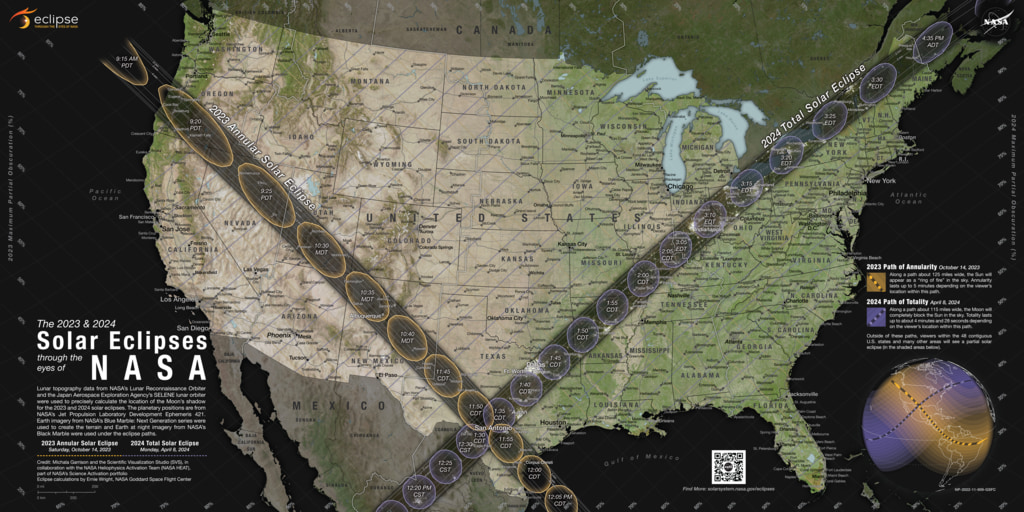Solar Eclipse 2024
Contact
University of Arkansas System Division of Agriculture
Cooperative Extension Service
2301 S. University Ave.
Little Rock, AR 72204

Solar Eclipse 2024
Everyone seems to have caught eclipse fever. This is understandable because solar eclipses are unusual celestial events that usually happen somewhere else, not Arkansas. Our last total eclipse was in 1918, and the April 8th event will be only our third in recorded history in the state. While most people seem to be focused on the spectacle of the event, my curiosity has been aroused about how scientists can so precisely predict when and where an eclipse will occur.

Solar eclipses aren’t especially rare. They happen somewhere on Earth about every 18 months, but for it to occur in the same location expect to wait 375 years. However, they will visit the same vicinity more frequently, as witnessed by the August 2017 eclipse that passed north of the state. People have been able to predict eclipses for almost 3,000 years.
Chaldea, a small kingdom in Mesopotamia that existed between the 9th and 6th century BCE and was later absorbed into the Babylonian empire (now modern-day Iraq), produced a population of keen observers and excellent record keepers. On clay tablets, they recorded the occurrence of regional eclipses and finally had amassed enough data to discern a pattern of occurrence. They occurred every 18 years and 11, 12 or 13 days, depending of course on leap years. This cycle eventually became known as the saros cycle, so named by Edmond Halley (of comet fame) in 1686. Greek and Arab scholars knew of the periodicity of eclipses, but weren’t able to predict where they would occur.
The saros cycle is complex to describe, but an eclipse can only occur when the Earth, moon and sun are in a straight line. The moon’s orbit around Earth is elliptical with its plane 5 degrees out of sync with our planet. The Earth’s orbit around the sun is also elliptical with our relative rate of movement changing depending on how close or far we are in our orbital path. All of this movement can be calculated and understood by better math minds than mine, but suffice it to say that saros cycles repeat themselves about every 18 years, but the location of the eclipse keeps changing.
To further complicate things, a saros cycle is just one part of a saros series. The average saros series includes about 75 saros cycles. The April 8, 2024 eclipse is saros series 139, which began in 1501 and will continue until 2763. This eclipse is the 30th in the series. At any one time, there are about 40 different saros series operating simultaneously. The 2017 eclipse was in saros series 145. It started in 1639 and will run through 3009.
The ability to predict where an eclipse will happen is often credited to Edmond Halley, who drew a map based on his understanding of the saros cycle while incorporating Newtonian physics into the mix. His map predicted an eclipse across England in 1715. His centerline was off by only 20 miles and his timing by only four minutes. It turns out that his predictions got the most press, but other scientists of his era were making similar predictions. The cause for the interest in understanding celestial movements was not so much to predict eclipses but to devise a means of determining longitude in the open ocean. At the time the ability to determine latitude had been worked out, but without a reliable means of measuring longitude, it was hard for ship’s captains to know where they were.
Because so many saros series are operating at any one time, it takes a lot of time and energy to predict the path and timing of an eclipse using this means. Since the 1980s computers have been used to make the calculations. NASA has compiled a convenient guide, Five Millennium Cannon of Solar Eclipses; -1999 to +3000, that shows when and where you can find your next eclipse viewing opportunity. The computations use pattern recognition software and include over 38,000 repeated mathematical terms to sus out the results.
The April 8 eclipse will be a grand affair, with the total eclipse lasting four and a half minutes along the midline of the path, which enters the state near De Queen and exits near Pocahontas a few minutes later. The path of totality will be about 125 miles wide, so a good portion of the state will be able to experience the spectacle. I’ll be viewing from Dardanelle and keeping my fingers crossed for clear weather because I probably won’t be around for the 2044 repeat engagement. According to weather data, we have about a 50 percent chance of clear skies.